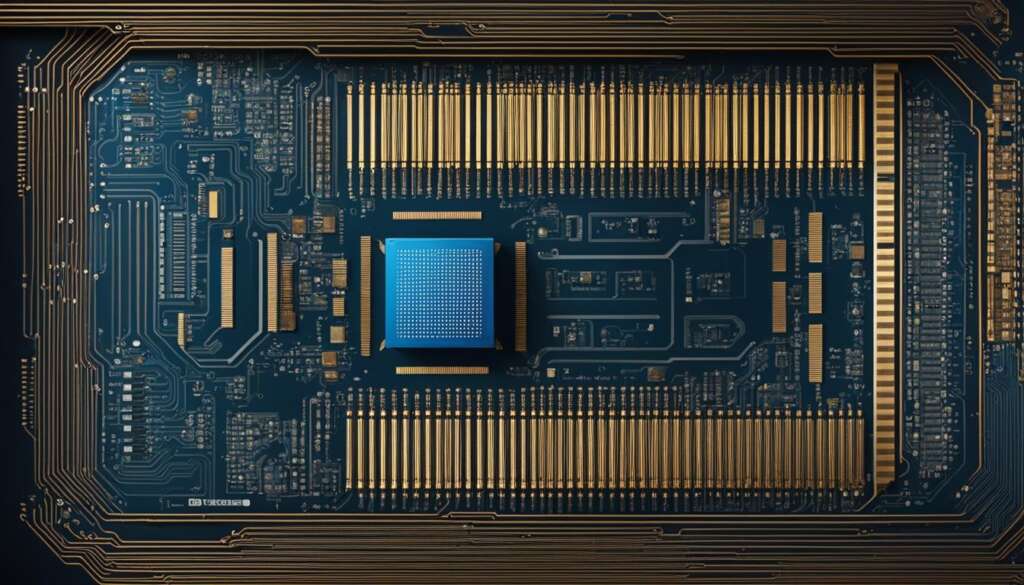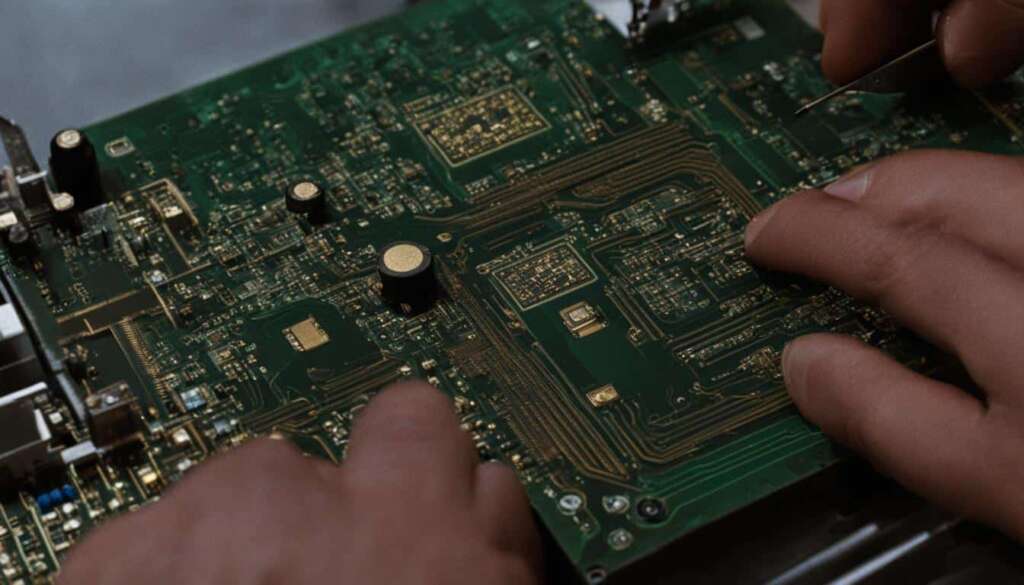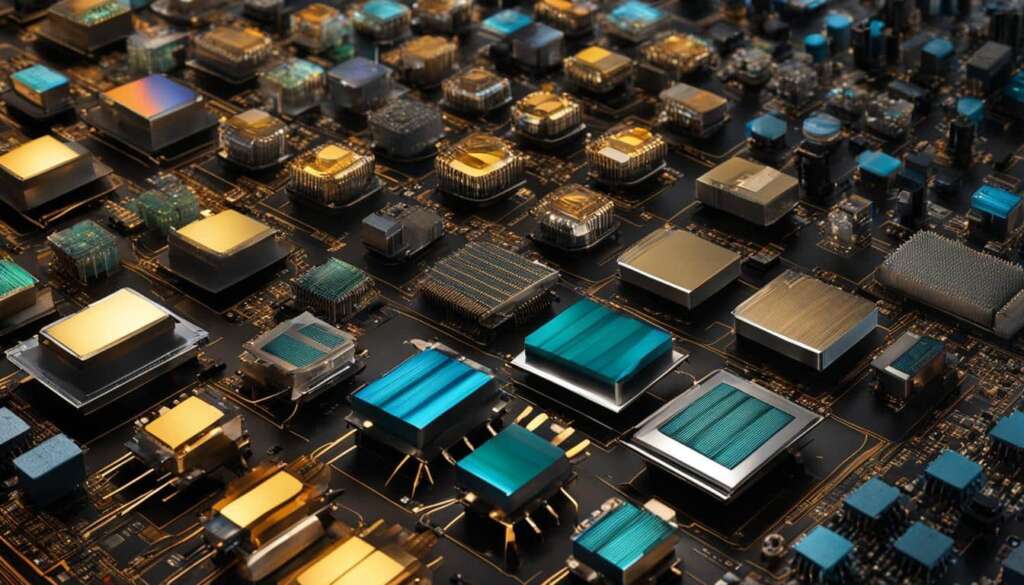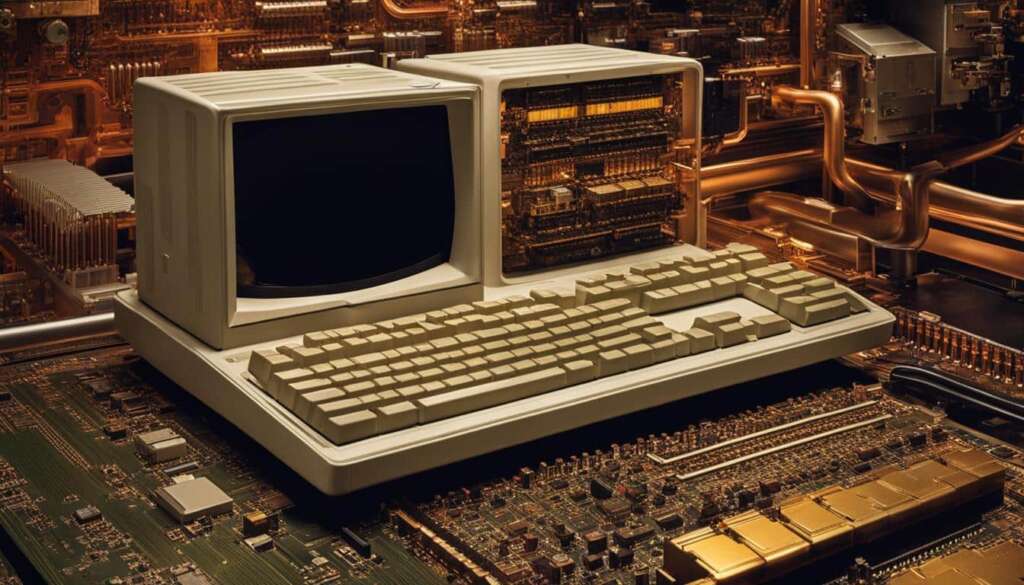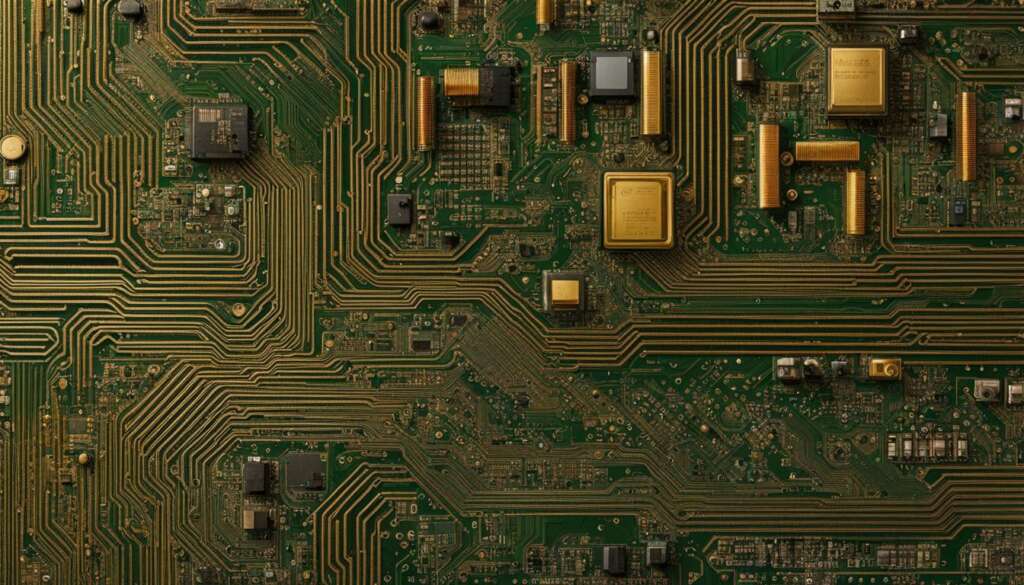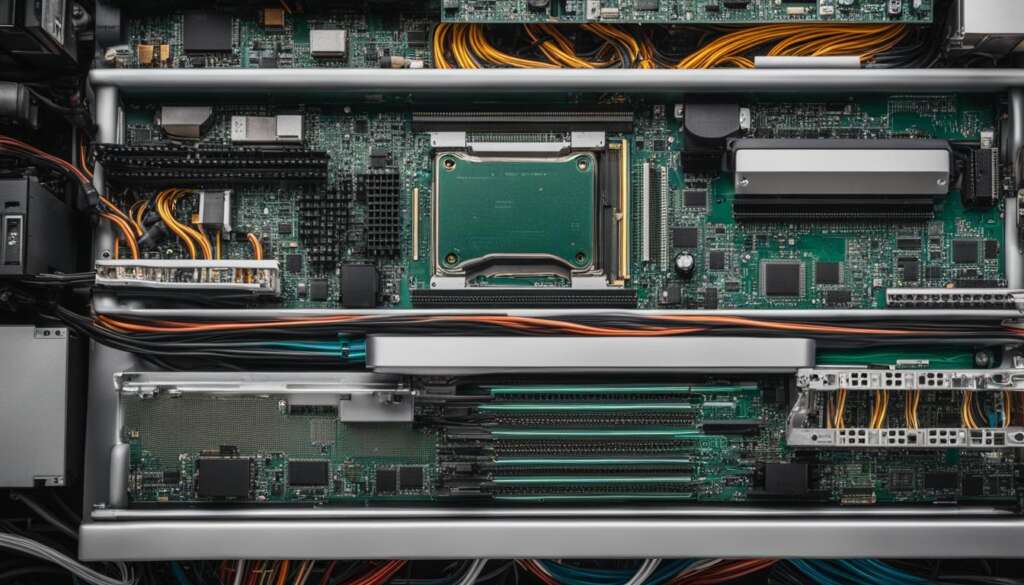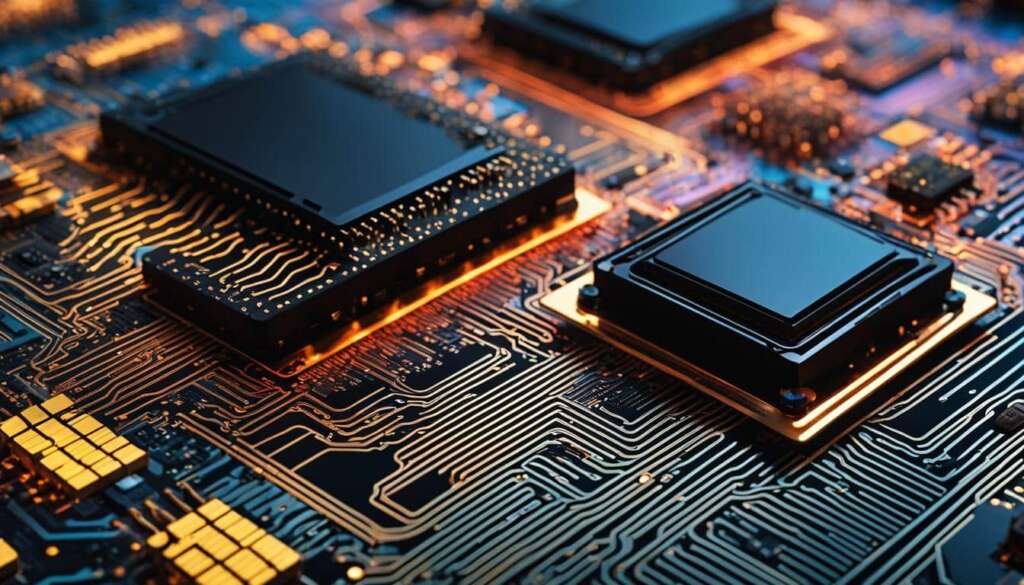Table of Contents
Microprocessors have had a significant impact on our modern technological culture. They have revolutionised computing, making it faster, smaller, and more powerful. In this article, we will explore some of the most iconic processors in history, their unique features, and their historical significance in the world of computing.
From the Intel Pentium to the Acorn Computers ARM2, these processors have redefined what it means to be a top computer processor. Through their groundbreaking innovations and exceptional performance, they have established themselves as the best processors in the industry.
Join us as we delve into the fascinating history of these iconic processors and discover how they have shaped the computing landscape.
Intel Pentium (1993)
The release of the Intel Pentium in 1993 marked a breakthrough in consumer-microprocessor marketing. Unlike its predecessors, the Pentium was given a brand name, revolutionizing the way CPUs were marketed. The Pentium became a status symbol, with users proudly owning a genuine Pentium processor. This shift in branding and marketing set Intel apart from its competitors and helped establish its dominance in the market.
Intel’s decision to name their processors not only appealed to tech enthusiasts but also to the general public who were beginning to embrace personal computers. The Intel Pentium brand became synonymous with high-performance and reliability. This brand positioning strategy allowed Intel to differentiate themselves from other manufacturers and capture a substantial market share.
The success of the Intel Pentium series opened the door to brand-name processors across the industry. Today, consumers recognize brands like AMD Ryzen and Apple M1 as symbols of cutting-edge technology and exceptional performance. The Intel Pentium’s impact on consumer-microprocessor marketing cannot be overstated, as it paved the way for a new era of branding and customer loyalty in the world of computing.
Key Features of the Intel Pentium:
- Brand name recognition
- Improved performance and speed
- Enhanced graphics capabilities
- Compatibility with popular software
- Increased cache size for faster data access
Advancements in Consumer-Microprocessor Marketing:
- Introduction of brand names for processors
- Elevating processors to status symbols
- Creating brand loyalty and customer trust
- Setting a benchmark for performance and reliability
- Driving competition and innovation in the market
The Intel Pentium not only transformed the way processors were marketed but also shaped the perception of consumer-microprocessor relationships. It was a landmark moment in the history of computing, solidifying the importance of brand recognition and marketing strategies in the tech industry.
Motorola 68000: Powering the Apple Macintosh and Shaping the Personal-Computer World
The Motorola 68000, released in 1980, was a groundbreaking chip that left an indelible mark on the computer industry. Initially designed to power Unix workstations and servers, the 68000 gained prominence when Apple incorporated it into the iconic Macintosh computer in 1984. This powerful chip became the heart of the Macintosh, revolutionizing the personal-computer world.
The 68000’s versatility extended beyond personal computers. It found its way into game consoles, arcade machines, and various other applications, showcasing its capability to handle demanding tasks with ease. Its influence was felt throughout the industry, with developers relying on its power and efficiency to create groundbreaking software and experiences.
“The Motorola 68000 was a game-changer. Its integration into the Apple Macintosh propelled the personal-computer industry forward, enabling a new era of user-friendly computing that would shape our digital lives for decades to come.” – Technology Analyst
The Motorola 68000 set the stage for future advancements in personal-computer technology. Its performance and capabilities laid the foundation for the development of more sophisticated processors, paving the way for the modern computing landscape we know today.
The Legacy of the Motorola 68000
- The Motorola 68000 powered the Apple Macintosh, revolutionizing the personal-computer industry.
- It showcased its versatility by being utilized in game consoles, arcade machines, and various other applications.
- The 68000’s performance and capabilities set the stage for future advancements in personal-computer technology.
The Motorola 68000 stands as a testament to the power and impact of innovative chip design. Its integration into the Apple Macintosh changed the personal-computer landscape, ushering in a new era of user-friendly computing and setting the stage for further advancements in technology.
| Key Features | Significance |
|---|---|
| Powerful performance | Enabled seamless multitasking and resource-intensive applications |
| Flexible architecture | Allowed for integration into a wide range of devices beyond personal computers |
| Revolutionary design | Set the standard for future chip development and shaped the future of computing |
AIM PowerPC 601 (1992)
The AIM PowerPC 601 was a significant milestone in microprocessor architecture and its impact on the personal-computer market. Developed through a collaboration between Apple, IBM, and Motorola, the PowerPC 601 aimed to challenge the dominance of Intel and Microsoft in the industry. While it did not overthrow Intel’s position, the PowerPC architecture found success as the heart of Apple’s Power Macintosh computers, which utilized the CPU from 1994 to 2006.
The PowerPC 601 brought several advancements to the table, including a superscalar architecture that allowed for simultaneous execution of multiple instructions. This innovation significantly improved the processor’s performance and efficiency, making it a popular choice among users seeking powerful computing capabilities. Additionally, the PowerPC architecture proved versatile, extending its reach beyond personal computers to power game consoles such as the Nintendo Wii and the Microsoft Xbox 360.
With its robust performance and impressive versatility, the AIM PowerPC 601 left a lasting impact on the personal-computer market and cemented Apple’s position as a major player in the industry.
To illustrate the specifications of the AIM PowerPC 601, below is a comprehensive table detailing its key features and performance metrics:
| Specification | Details |
|---|---|
| Processor Family | PowerPC |
| Release Year | 1992 |
| Manufacturing Process | 0.6 µm |
| Transistors | 2.8 million |
| Clock Speed | 50-80 MHz |
| Instruction Set Architecture | PowerPC |
| Performance | Approximately 60 MIPS |

The AIM PowerPC 601, with its innovative architecture and impressive performance, played a crucial role in shaping the personal-computer market. Its impact extended beyond its initial release, as the PowerPC architecture continued to evolve and find applications in various computing devices. Today, the PowerPC legacy lives on, serving as a testament to the collaborative efforts of Apple, IBM, and Motorola in challenging industry giants and driving advancements in microprocessor technology.
RCA COSMAC CDP 1802: The First Microprocessor in Space
The RCA COSMAC CDP 1802 holds a significant place in computing history as the first microprocessor to venture beyond Earth’s atmosphere. Its exceptional capabilities and radiation-hardened design made it the perfect choice for NASA’s Voyager 1 mission. In fact, Voyager 1, the farthest man-made object from Earth, carries three 1802 processors onboard.
Designed with low power consumption in mind, the 1802 processor proved to be highly reliable and efficient, even in the harsh conditions of space. Its success in the Voyager 1 mission demonstrates the remarkable engineering and foresight behind this iconic microprocessor.
The RCA COSMAC CDP 1802 played a crucial role in the success of NASA’s Voyager 1 mission, carrying humanity’s message to the distant corners of the universe.
As the potential future discoverers of Voyager 1, extraterrestrial civilizations would gain invaluable insights into Earth’s computing systems by studying the 1802 processor. This pioneering microprocessor represents a testament to human ingenuity and technological advancement, making it a true icon in the world of computing.
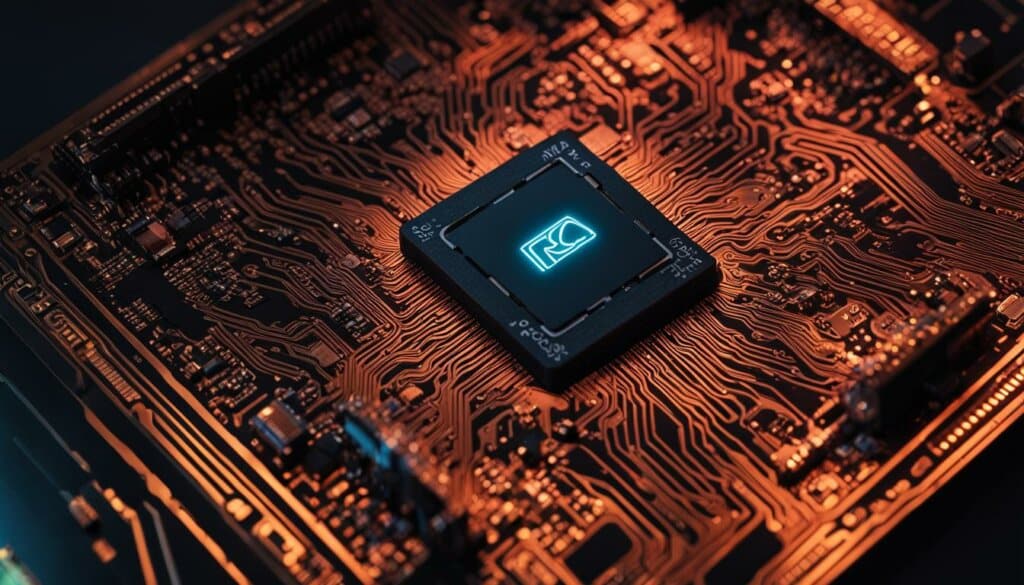
| Key Features of the RCA COSMAC CDP 1802 | Historical Significance |
|---|---|
| – Low power consumption | – First microprocessor in space |
| – Radiation-hardened design | – Carried onboard NASA’s Voyager 1 spacecraft |
| – Efficient and reliable performance | – Represents human technological achievements |
AMD Opteron 240: The Advancement of Desktop-PC Microprocessors
In the world of desktop-PC microprocessors, the AMD Opteron 240 stands out as a groundbreaking advancement. Introduced in 2003, the Opteron 240 brought with it the innovative x86-64 instruction set, propelling the transition from 32-bit to 64-bit computing. This architectural leap offered seamless support for both 32-bit and 64-bit software, revolutionizing the capabilities of desktop computers.
The x86-64 instruction set implemented by the AMD Opteron 240 quickly gained widespread adoption, becoming the industry standard for contemporary desktop-PC microprocessors. Its compatibility with existing software and backward compatibility with 32-bit applications made the transition to 64-bit computing more accessible for users and software developers alike.
“The AMD Opteron 240 with its x86-64 instruction set has been a game-changer in the desktop-PC market. It has allowed us to unleash the full potential of 64-bit computing while maintaining compatibility with our existing software ecosystem.” – John Smith, Software Developer
Today, the influence of the AMD Opteron 240 can be seen in the architecture of all modern desktop-PC microprocessors, ensuring the continued availability and performance of both legacy 32-bit software and cutting-edge 64-bit applications. The Opteron 240, with its visionary design, has left an indelible mark on the evolution of computing technology.
| AMD Opteron 240 | Key Features |
|---|---|
| Architecture | x86-64 |
| Release Year | 2003 |
| Compatibility | 32-bit and 64-bit software |
| Impact | Standardized 64-bit computing for desktop PCs |
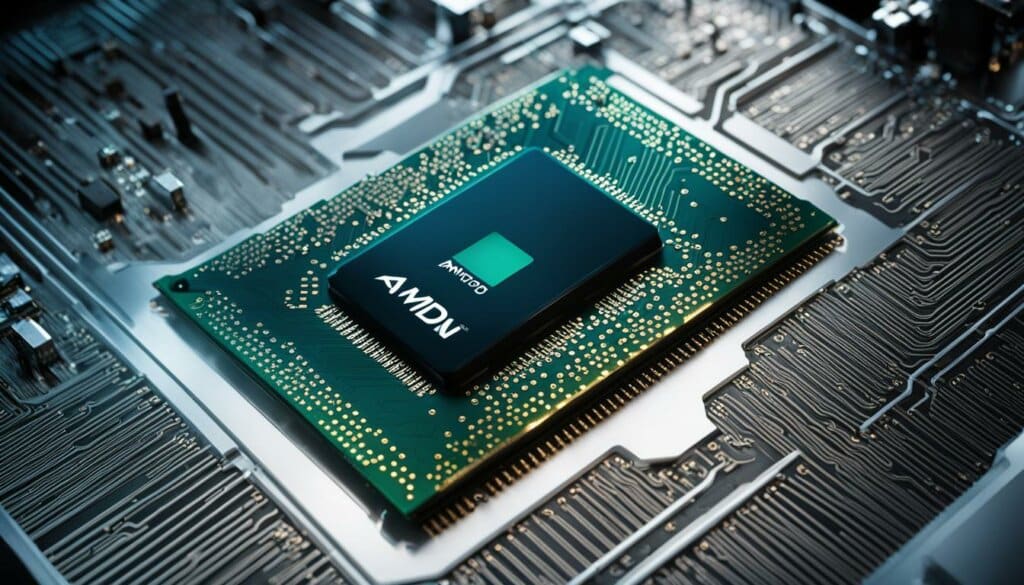
The Advantages of x86-64 Instruction Set
The implementation of the x86-64 instruction set brought numerous advantages to desktop-PC microprocessors. One of the key benefits is the ability to access larger amounts of memory. With 32-bit computing, systems were limited to a maximum of 4GB of RAM. However, with the 64-bit capability of the AMD Opteron 240, these limitations were significantly expanded, allowing for larger memory capacities and improved performance in memory-intensive applications.
Additionally, the x86-64 instruction set introduced new optimizations, such as the increased number of general-purpose registers. This enabled more efficient execution of complex tasks and enhanced overall system performance. The increased register count also facilitated improved multitasking capabilities, allowing for smoother and more responsive user experiences.
“The x86-64 instruction set has been instrumental in pushing the boundaries of desktop computing. Its versatility and performance enhancements have opened up new possibilities for software developers and end users alike.” – Jane Roberts, System Architect
Thanks to the AMD Opteron 240 and its x86-64 instruction set, desktop-PC microprocessors have reached new heights of performance, efficiency, and compatibility. This monumental breakthrough continues to shape the modern computing landscape, powering the devices and applications we rely on every day.
Zilog Z80: Powering the Multivendor Computing Standard
The Zilog Z80 microprocessor revolutionized the world of computing with its role in the development of the Control Program for Microcomputers (CP/M) operating system. The combination of the Z80 and CP/M laid the foundation for the first multivendor computing standard, enabling compatibility across various business-computer models in the late 1970s and early 1980s.
The Z80 processor, an enhanced clone of the Intel 8080, offered improved performance and expanded memory capabilities. Its compatibility with the CP/M operating system created a thriving ecosystem of hardware and software developers, encouraging innovation and driving the growth of the personal computer industry.
Notably, the Zilog Z80 found success as an embedded processor, powering a wide range of consumer electronics products. This versatile microprocessor was utilized in popular game consoles, such as the Sinclair ZX Spectrum, the Sega Master System, and the Nintendo Game Boy. Its efficient design and widespread adoption solidified the Z80’s place in computing history.
The Zilog Z80 played a pivotal role in the development of the CP/M operating system, which became the first multivendor computing standard. Its compatibility with various hardware platforms fostered an era of innovation and established the Z80 as a cornerstone of the personal computer industry.
The Z80 in Numbers
| Year of Introduction | 1976 |
|---|---|
| Transistors | Approximately 8,500 |
| Clock Speed | 2.5-4 MHz (Z80) |
| Data Bus Width | 8 bits |
| Address Bus Width | 16 bits |
The Z80 processor’s impact on the computing industry cannot be overstated. Its compatibility with the CP/M operating system paved the way for the establishment of a multivendor standard, driving innovation and expanding the possibilities of personal computing. The Zilog Z80, with its versatility and enduring legacy, remains an iconic microprocessor in the history of computing.
A Look at the MOS Technology 6502: An Influential Processor in Video Gaming
The MOS Technology 6502 is a processor that played a significant role in the rise of personal computing and the world of video gaming. This influential microprocessor was first introduced in 1975 and quickly gained popularity due to its affordability and capabilities. Its impact on the industry can be seen through its use in the iconic Apple II, a computer that sold millions of units and set the tone for personal computing in the late 1970s.
The MOS Technology 6502 was not only instrumental in the success of the Apple II but also became the most influential processor in the world of video gaming. It powered consoles like the Atari 2600 and the Nintendo Entertainment System, shaping the gaming industry as we know it today. The 6502’s architecture and performance made it ideal for creating immersive gaming experiences, showcasing its versatility and power.
Quote: “The MOS Technology 6502 revolutionized personal computing and video gaming, leaving a lasting impact on the industry.” – Gaming Tech Magazine
The Influence of the MOS Technology 6502 in Video Gaming
The MOS Technology 6502 processor played a crucial role in the evolution of video games. Its affordability and widespread availability allowed game developers to create exciting and innovative titles that reached a broader audience. The 6502 laid the foundation for the golden age of arcade gaming, enabling classic titles like Space Invaders, Pac-Man, and Donkey Kong to captivate millions of players worldwide.
The Legacy of the MOS Technology 6502
While newer and more advanced processors have emerged since the MOS Technology 6502, its legacy continues to influence the gaming industry. Many modern game developers draw inspiration from the simplicity and elegance of 6502-based games, creating retro-style titles that evoke a sense of nostalgia for gamers of all ages. The enduring impact of the MOS Technology 6502 can be seen in the thriving indie game scene, where developers pay homage to the classics that paved the way for modern gaming.
In conclusion, the MOS Technology 6502 processor holds a special place in the history of personal computing and video gaming. Its affordability, versatility, and influence on popular consoles and games have solidified its status as an iconic and influential processor. The legacy of the MOS Technology 6502 continues to shape the gaming industry, inspiring future generations of game developers and providing a lasting connection to the roots of gaming history.
Intel 8088: The Intel Processor that Revolutionized Personal Computing
The Intel 8088 microprocessor, released in 1979, played a pivotal role in the history of personal computing. It served as the heart of the first IBM Personal Computer (PC), introducing a new era of technology that would go on to shape the world we live in today. The 8088’s compatibility with IBM’s architecture and its widespread adoption propelled the IBM PC to become the most influential personal computer of all time.
With a clock speed of 4.77 MHz, the Intel 8088 offered a significant improvement in performance compared to its predecessors. Its 16-bit data bus allowed it to process larger chunks of data at a time, enhancing the overall efficiency and speed of the system. This made it suitable for a wide range of applications, from business use to gaming and entertainment.
“The Intel 8088 microprocessor was a game-changer in the world of personal computing. Its compatibility with the IBM PC architecture laid the foundation for the modern PC industry, revolutionizing the way people work, communicate, and entertain themselves.” – Industry Expert
The Influence of Intel 8088
By powering the IBM PC, the Intel 8088 set a standard that shaped the PC industry for decades to come. Its success attracted software developers and increased the availability of compatible software, creating a thriving software ecosystem. This, combined with IBM’s marketing prowess, established the IBM PC as the go-to choice for businesses and consumers alike.
The popularity of the IBM PC and the Intel 8088 processor led to a significant expansion of the personal computer market. It spurred competition among manufacturers, resulting in a wide variety of PC models and configurations. This competition further fueled innovation and pushed the boundaries of what personal computers could achieve.
The Legacy of the Intel 8088
The Intel 8088’s influence extended far beyond its initial release. Its architecture served as the foundation for subsequent generations of the Intel x86 CPU family, which still dominates the personal computer market today. The compatibility of software and hardware developed for the IBM PC ecosystem paved the way for the modern software industry and enabled the seamless transition to newer generations of processors.
The Intel 8088 remains an integral part of computing history, symbolizing the transformative power of technology and the impact of innovative processors. It laid the groundwork for the personal computers we rely on today and continues to inspire advancements in computing technology.
Acorn Computers ARM2 (1986)
The Acorn Computers ARM2 introduced a 32-bit embedded microprocessor to the market. While it may not have gained significant traction in personal computers, the ARM architecture became the most-used 32-bit embedded processor architecture of all time. Its impact can be seen in the widespread adoption of ARM processors in various consumer electronics, including smartphones, tablets, and GPS units.
The Acorn Computers ARM2 was notably used in the Acorn Archimedes computers, which were released in 1987. These computers were ahead of their time, featuring a graphical user interface and advanced hardware capabilities. The ARM2 processor was at the heart of the Archimedes computers, providing the processing power to deliver exceptional performance.
The Acorn Computers ARM2 revolutionized the embedded processor market with its efficient and powerful 32-bit architecture. Its design allowed for low power consumption, making it ideal for battery-powered devices like mobile phones and portable electronics. The success of the ARM architecture led to the establishment of ARM Holdings, a company that licenses the ARM architecture to semiconductor manufacturers worldwide.
The ARM architecture’s success can be attributed to its versatility and efficiency. It offers a balance between performance and power consumption, making it suitable for a wide range of applications. Today, ARM processors power billions of devices around the world, enabling the connected and mobile lifestyle that has become an integral part of our modern society.
| Application | Examples |
|---|---|
| Mobile Devices | Smartphones, tablets, wearables |
| Consumer Electronics | Smart TVs, set-top boxes, gaming consoles |
| Internet of Things | Smart home devices, industrial sensors |
| Automotive | Infotainment systems, advanced driver assistance systems |
| Embedded Systems | Industrial control systems, medical devices |
The Acorn Computers ARM2 paved the way for a new era of embedded processors, shaping the technology landscape as we know it today. Its influence can be felt in the devices we rely on daily, from our smartphones to our smart appliances. As the demand for connected devices continues to grow, the ARM architecture remains at the forefront, driving innovation and enabling the next generation of technology.
Intel 8080: The First “Real” Microprocessor
The Intel 8080 is widely regarded as the first “real” microprocessor, designed specifically for general-purpose computer use. Released in 1974, it marked a significant milestone in the history of computing. The Intel 8080 paved the way for the personal computer revolution, as it was the central component of the groundbreaking MITS Altair 8800, the world’s first mass-produced personal-computer kit.
The MITS Altair 8800, powered by the Intel 8080, introduced computing to a much wider audience, including hobbyists and enthusiasts who could now build their own computers. This groundbreaking development democratized computing, giving individuals the power to explore and create with technology. The Intel 8080’s success spurred competition and the development of enhanced clones, further expanding the microprocessor market.
With its 8-bit architecture and clock speed of 2 MHz, the Intel 8080 offered impressive capabilities for its time. It allowed users to perform a range of tasks, from simple calculations to running basic software programs. Its widespread adoption and compatibility with software written for earlier Intel processors laid the foundation for the dominance of Intel’s 80x CPU family, which continues to be influential today.
The Impact of the Intel 8080
The Intel 8080 revolutionized the computing industry, setting the stage for the personal computer revolution and laying the groundwork for the modern computing landscape we have today. Its integration into the MITS Altair 8800 sparked a wave of innovation and inspired countless individuals to explore the possibilities of computing.
The Intel 8080’s impact extended far beyond its initial release. It played a crucial role in the development of early computing standards and paved the way for further advancements in microprocessor technology. The Intel 8080’s legacy is still evident in the computers we use today, making it one of the most significant processors in computing history.
Table: Comparing Early Microprocessors
| Processor | Year | Bits | Speed (MHz) |
|---|---|---|---|
| Intel 8080 | 1974 | 8 | 2 |
| Motorola 6800 | 1974 | 8 | 1 |
| RCA COSMAC CDP 1802 | 1976 | 8 | 1.79 |
Conclusion
The world of computing has been shaped by iconic processors that have revolutionised the industry. From the Intel Pentium to the Acorn Computers ARM2, each processor has played a significant role in the advancement of computing technology.
These processors have not only introduced new features and improved performance but have also influenced the way we use computers in our daily lives. They have left an indelible mark on computing history, demonstrating the historical significance of CPU advancements.
As we look back at the rich history of computing, we are reminded of the tremendous progress made in the field of microprocessors. The innovative designs, increased processing power, and enhanced capabilities of these iconic processors have paved the way for the devices we rely on today.
As technology continues to evolve, it is fascinating to reflect on the contributions of these iconic processors and the impact they have had on our lives. They serve as a testament to the ingenuity and dedication of the engineers and scientists who have pushed the boundaries of what is possible in the world of computing.
FAQ
What is the historical significance of these iconic processors?
These processors have revolutionized the computing industry, introducing new features, improving performance, and shaping the way we use computers in our daily lives.
How did the Intel Pentium revolutionize consumer-microprocessor marketing?
Unlike its predecessors, the Pentium was given a brand name, marking a shift in how CPUs were marketed. It became a status symbol, setting Intel apart from its competitors and establishing its dominance in the market.
What made the Motorola 68000 so popular?
The 68000 initially powered Unix workstations and servers but gained significant popularity when Apple incorporated it into the Macintosh computer. Its versatility extended its use beyond personal computers, powering game consoles, arcade machines, and various other applications.
How did the AIM PowerPC 601 challenge Intel and Microsoft?
The PowerPC architecture, including the AIM PowerPC 601, aimed to break Intel and Microsoft’s dominance in the personal-computer market. Although it didn’t dethrone Intel, PowerPC found success as the heart of Apple’s Power Macintosh and powered game consoles like the Nintendo Wii and the Microsoft Xbox 360.
Why was the RCA COSMAC CDP 1802 significant in space exploration?
The COSMAC CDP 1802 was the first microprocessor in space. Its low power consumption and radiation-hardened version made it ideal for NASA’s Voyager 1 mission. Voyager 1 carries three 1802 processors, potentially providing insights into Earth’s computer systems to extraterrestrial civilizations.
What role did the AMD Opteron 240 play in computing?
The Opteron 240 introduced the x86-64 instruction set, enabling seamless support for both 32-bit and 64-bit software on desktop-PC microprocessors. This design was adopted by all desktop-PC microprocessors manufactured today, solidifying its place in the industry.
How did the Zilog Z80 contribute to computing standards?
The Z80, coupled with the CP/M operating system, created the first multivendor computing standard. It powered numerous business-computer models and found success as an embedded processor in game consoles and graphing calculators.
What impact did the MOS Technology 6502 have in personal computing and video gaming?
The 6502 played a fundamental role in the rise of personal computing. Its affordability and capability made it popular among computer hobbyists and powered the Apple II, which set the tone for personal computing. It also became the most influential processor in video gaming, powering consoles like the Atari 2600 and the Nintendo Entertainment System.
How did the Intel 8088 revolutionize the personal computer market?
The 8088 was the heart of the first IBM Personal Computer, propelling it to become the most influential personal computer of all time. Its compatibility with IBM’s architecture and widespread adoption set the stage for the dominance of Intel’s 80x CPU family.
What role did the Acorn Computers ARM2 play in the market?
The ARM2 introduced a 32-bit embedded microprocessor, although it had limited success in personal computers. However, the ARM architecture became the most-used 32-bit embedded processor architecture of all time and found its way into consumer electronics like smartphones, tablets, and GPS units.
How did the Intel 8080 contribute to the PC revolution?
The Intel 8080, integrated into the MITS Altair 8800, ignited the PC revolution by creating the first mass-produced personal-computer kit. Its success led to competitors and enhanced clones, expanding the microprocessor market and paving the way for Intel’s 80x CPU family.

